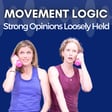
99: Is the Sitting-Rising Test a Lifespan Predictor - or Just Hype?
In this 'Inbetweenie' episode of the Movement Logic podcast, Sarah delves into the widespread misinterpretation of a 2014 research study titled 'Ability to Sit and Rise from the Floor as a Predictor of All-Cause Mortality.' Popularly known as the Sitting Rising Test (SRT), the study has been sensationalized in the media and on social platforms, claiming that the ability (or inability) to get up from the floor without assistance can predict mortality. Sarah critiques the study's methodology, the pitfalls of its media representation, and the critical difference between correlation and causation. She also emphasizes the importance of proper interpretation to avoid fear-mongering and encourages training in strength and balance for overall health benefits.
Get on our Wait List for the Bone Density Course!
Follow us on Instagram @movementlogictutorials
01:08 Overview of the Misinterpreted Study
03:35 Details of the Sitting Rising Test (SRT)
04:21 Methodology and Findings of the Study
14:33 Critique of the Study's Methodology
23:43 Misinterpretations and Media Hype
29:17 Conclusion and Final Thoughts
References:
Episode 15: 3! Easy! Rules! About! Research!
Ability to sit and rise from the floor as a predictor of all-cause mortality(abstract)
Conor O’Shea podcast: Taking Control of Your Pain Through Movement
Discover Magazine: Simple Sitting Test Predicts How Long You'll Live


